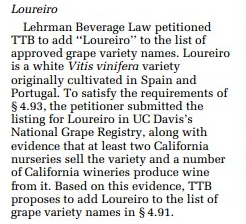 Last year, I represented a client before the Alcohol and Tobacco Tax and Trade Bureau (TTB) with respect to petitioning for the addition of a new grape variety for use as a variety on American wine labels. The grape variety, Loureiro, has been used on imported wines from Portugal and Spain. Its use in the United States is expanding, but before our petition was filed, TTB did not recognize the use of “Loureiro” as a grape variety for American wines. It thus could not be approved as a varietal wine. Several U.S. producers were actually very creative with their labels and used the phonetic spelling of Loureiro as their fanciful name (in an attempt to circumnavigate TTB’s regulations with respect to grape varieties).
Last year, I represented a client before the Alcohol and Tobacco Tax and Trade Bureau (TTB) with respect to petitioning for the addition of a new grape variety for use as a variety on American wine labels. The grape variety, Loureiro, has been used on imported wines from Portugal and Spain. Its use in the United States is expanding, but before our petition was filed, TTB did not recognize the use of “Loureiro” as a grape variety for American wines. It thus could not be approved as a varietal wine. Several U.S. producers were actually very creative with their labels and used the phonetic spelling of Loureiro as their fanciful name (in an attempt to circumnavigate TTB’s regulations with respect to grape varieties).
TTB published a notice in the Federal Register in November, listing several proposed grape varieties for which the agency had received and reviewed petitions (including Loureiro). I actually wrote about the process last year in The Importance of Grape Varieties on American Wine Labels, which is very interesting for a wine law nerd like myself. In summary, when TTB receives a petition for a new, proposed grape variety and, upon reviewing and determining that the petition should proceed, it will grant administrative approval to the grape variety. The easiest way to think about it is that the administrative approval is a temporary approval and whether or not it becomes an “official” approval depends greatly on the regulatory process (summarized below).
This means that the TTB will approve of wine labels that use said grape variety as the varietal through its COLA process (during the time period where the grape variety has been issued “administrative approval” and before a final rule has been issued by the agency), but such approvals are valid for labels used in the U.S. market and do not imply that the use of such variety names is acceptable in other countries. The COLA will also depend on the future success of the grape variety on the administrative level — in other words, the grape variety must go through the rule making process before it officially becomes part of TTB regulations (27 CFR 4.91) for grape varieties and wine labels. This is all detailed more in 27 CFR 4.93.
Shortly after issuing the administrative approval, the agency publishes a notice in the Federal Register (such as the notice here) and invites comments from industry members with respect to the proposed grape varieties. Comments for TTB’s most recent proposed grape varieties actually ends on January 17, 2017 (you can comment through the Regulations.gov website here).
After TTB receives initial comments through its proposed rule, it will review the comments and either extend comment time or issue a final rule (which may vary from the original, proposed rule depending on the comments that TTB receives). This is somewhat similar to the administrative process TTB undergoes when new or altered American Viticultural Areas are proposed (although requirements for petitions, clearly, differ).
For more information on wine or alcohol law, or submitting a varietal petition to TTB, please contact Lindsey Zahn.
DISCLAIMER: This blog post is for general information purposes only, is not intended to constitute legal advice, and no attorney-client relationship results. Please consult your own attorney for legal advice.